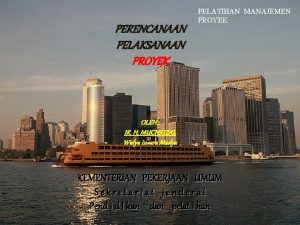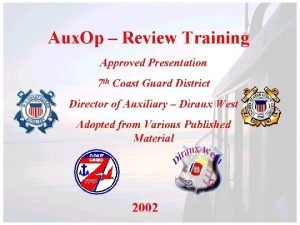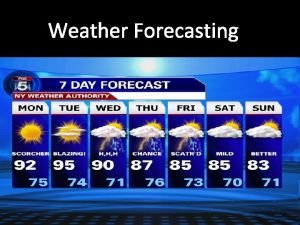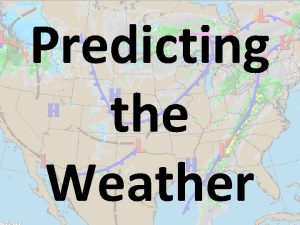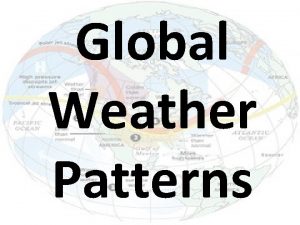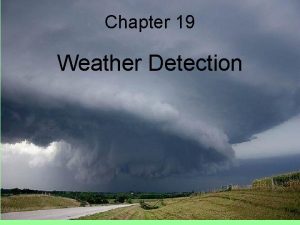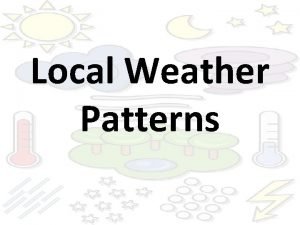Heavy Weather What is Heavy Weather A 1977



















- Slides: 19

Heavy Weather

What is Heavy Weather? �A 1977 album by jazz group Weather Report? �A 1933 novel by P. G. Wodehouse? �Stormy winds? Conditions, rough seas, high �Song on Jarvis Cocker’s debut solo album? �All of the above?

Heavy Air vs Heavy Weather �Heavy Air Boat may need adjustment Course can be maintained �Heavy Weather Crew must take evasive action for safety Conditions dictate the action

Frequency / Likelihood � Circumnavigators experience Gale Force conditions < 1% of the time � Rogue Waves can occur where even a single wave can be much higher than average wave height (even 2 x) � Cruising vs Racing When cruising, the purpose is to make a smart seamanlike passage with the minimum of wear and tear on the ship and the crew K Adlard Coles

Heavy Weather Conditions �Combination of Conditions Wind Conditions Rough, Confused Sea Large Waves Breaking Waves Sudden Wind Shifts Rain / Spray / Snow / Reduced Visibility Other Nasty Weather Conditions

Windscales � Near Gale (Force 7) Avg Wind Velocity 28 - 33 knots Avg Wave Heights 13. 5– 19 feet � Gale (Force 8) Avg Wind Velocity 34 - 40 knots Avg Wave Heights 18 – 25 feet � Strong Gale (Force 9) Avg Wind Velocity 41 - 47 knots Avg Wave Heights 23– 32 feet � � � Max wave heights may be 2 x Avg Gusts may be much higher Lower force might be considered Heavy Weather

Be Prepared For local Conditions �Pay Attention to the Weather Wait for weather window for passage Know what’s headed your way �Know What to Expect Locally Atlas of Pilot Charts / Local Publications ▪ Average windspeed, directions and wave heights for time of year �Tides & Currents in Area

Be Prepared Below Deck �Make galley shipshape Utensils & provisions �Stow all articles in Nav Station �Check the bilge pump is clear �Check floorboards, lockers, fridge �Ensure batteries are locked down �Have quick, high energy food and drink readily available. �Put up leecloths on bunks

Be Prepared Crew �Chart current position Make current log entry Note barometer reading Note sea room �Take seasickness meds 1 hour before �Remind crew of location of flares, fire extinguishers, flares etc. �Prepare flashlights �Check ditch bag �Don foul weather gear �Don PFD and safety harness �Keep eating and drinking

Be Prepared Above � Hoist / Check Radar Reflector � Stow or lash everything loose properly Any thing that can move will move Tools, Winch Handles, Bimini, jerry cans Poles etc � Check Dinghy Lashing � Check Jacklines � Shut all hatches � Ventilators to leeward � Close Engine Vents � Plug Hawse pipe � Lash Anchor � Make sure fog horn is accessible

Be Prepared Above �Close fuel cocks �Check cockpit lockers �Check cockpit drains are open �Close all seacocks �Prepare stormsails for use �Consider closing companionway hatch �Prepare warps for streaming �Prepare drogues / sea anchor �Check manual bilge pump / bailer

Heavy Weather Tactics �Reduce Sail �Employ Tactics Early On �Golden Rules (Beth Leonard) Avoid Breaking Waves Avoid taking seas beam-on ▪ Either bow-to or stern-to is better ▪ Balance boat for wind angle Prepare a variety of Tactics Avoid Fatigue

Sail Plan - Inventory � Mainsails � Reefs in Main Roller Reefing in Mast Roller Reefing in Boom Separate track in mast for storm trysail Headsails Storm Jib Roller Reefing Jib (as opposed to furling) � Foresails Storm staysail on (demountable? ) forestay High cut to avoid deck wash � Mizzen Sails ?

Heavy Weather Tactics � Heaving – To – slick of calm to windward � Forereaching � Reef main for conditions Backwind jib sized 80 -100% of fore-triangle Helm lashed to head to 40 -60 deg off apparent wind Balance to make only leeway (~ 1 -3 knots) Heave-to equivalent for multi-hull or modern fin keel monohull main with 1 extra reef, or trysail in high wind Helm lashed close-hauled Find balance on helm to make slow jogs back and forth to wind Slow headway towards destination With large waves heave-to / forereaching may need to be reconsidered as bow gets pushed off wind leaving yacht beam-to the wave train.

Heavy Weather Tactics �Lying Ahull – slick to windward Beam-to waves helm lashed to tend bow up to wind Bare Poles Cats only! Not for single hulls as they could roll

Heavy Weather Tactics �Scudding / Running Bare Poles or stabilizing flat staysail helps keep stern into the wind Need to reduce speed if yacht starts surfing ▪ Trailing Warps ▪ Sea Anchors ▪ Drogues

Heavy Weather Tactics �Practice Makes Perfect Need to select appropriate tactics and practice deploying them

Closing Thought �“Whatever decision you may make, if you get into trouble, you may be sure that someone who was not there will come up with something you should have done. ” John F. Wison, ‘Heavy Weather Guide’

References �The Voyageur’s Handbook – Beth Leonard �The International Marine Book of Sailing – Robby Robinson �Heavy Weather Sailing – K. Adlard Coles �Videos - You Tube
 Heavy weather by weather report
Heavy weather by weather report Shratey
Shratey 1977 seçimleri
1977 seçimleri Chuck close self portrait 1997
Chuck close self portrait 1997 Bandura 1977 social learning theory
Bandura 1977 social learning theory Flashbulb memory nedir
Flashbulb memory nedir Meyer rowan 1977
Meyer rowan 1977 Rumelhart 1977
Rumelhart 1977 Sni 03-1977-1990
Sni 03-1977-1990 Tukey 1977
Tukey 1977 Charts 1977 international
Charts 1977 international Rank and jacobson 1977
Rank and jacobson 1977 1969 1970 1971 1972 1973 1974 1975 1976 1977 1978
1969 1970 1971 1972 1973 1974 1975 1976 1977 1978 Claes oldenburg pastry case
Claes oldenburg pastry case Apa pengertian budaya organisasi menurut morga (1977)
Apa pengertian budaya organisasi menurut morga (1977) Drogentote berlin 1977
Drogentote berlin 1977 Incidental forgetting
Incidental forgetting Earoles
Earoles Personbas
Personbas Posebne uzance o građenju
Posebne uzance o građenju








